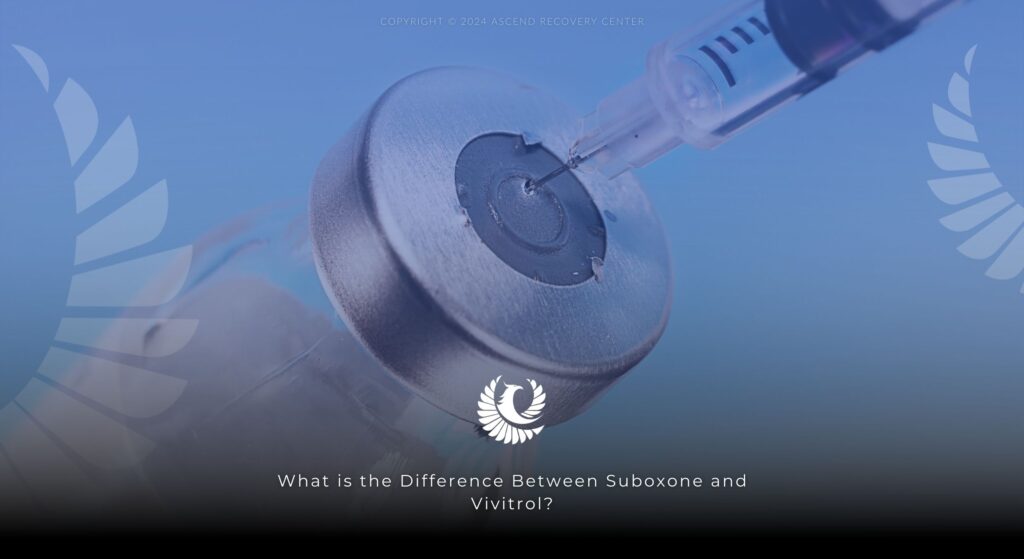Both Suboxone and Vivitrol are medications that are approved by the U.S. Food and Drug Administration (FDA) to treat substance use disorders. While both medications work by interacting with opioid receptors in the brain, there are several key differences between the two. In this article, you’ll learn what the difference is between Suboxone and Vivitrol as well as which one may be right for you.
What is Suboxone?
Suboxone is a prescription medication used in the treatment of opioid dependence. It was approved by the FDA in 2002. It contains two active ingredients: buprenorphine and naloxone.
Buprenorphine is a partial opioid agonist, meaning it activates the same receptors in the brain as opioids but to a lesser extent, helping to reduce opioid withdrawal symptoms and cravings without producing the same euphoric effects.
Naloxone is an opioid antagonist, which blocks the effects of opioids and helps prevent misuse.
Suboxone is typically administered as a sublingual film or tablet that is taken on a daily basis and is often used as part of a comprehensive addiction treatment program that includes counseling and behavioral therapy. This approach is known as medication-assisted treatment (MAT).
What is Vivitrol?
Vivitrol is a brand name for the medication naltrexone, which is used to prevent relapse in individuals who are struggling with opioid or alcohol addiction and have successfully undergone detoxification. It was originally approved by the FDA in 2006 for the treatment of alcohol dependence, but it was approved again in 2010 for the treatment of opioid dependence.
Unlike Suboxone, Vivitrol does not contain opioids. Instead, it is an opioid antagonist, meaning it blocks the effects of opioids by binding to the same receptors in the brain.
Vivitrol is administered as a once-monthly intramuscular injection, providing reduced cravings and protection against opioid or alcohol relapse with a steady dose of naltrexone. The monthly injection is usually prescribed as part of medication-assisted treatment (MAT).
Differences Between Suboxone and Vivitrol
Active Ingredient
Suboxone contains buprenorphine and naloxone, while Vivitrol contains naltrexone.
Method & Frequency of Administration
Suboxone is typically administered as a sublingual film or tablet and may be taken daily. It can be taken home with patients or given daily as part of a MAT clinic. Vivitrol is extended-release and is administered as a once-monthly intramuscular injection. The shot is generally administered in the glute muscle (buttocks) every 28 days. The Vivitrol shot is administered in the office by a healthcare provider.
Intended Use
Suboxone is used for the treatment of opioid use disorder, helping to reduce withdrawal symptoms and cravings. Vivitrol is used to prevent relapse in individuals who have already undergone detoxification from opioids or alcohol. However, both are intended to be used alongside counseling and behavioral therapy.
Side Effects
Common side effects of Suboxone may include nausea, headache, constipation, and insomnia. Some people who take Suboxone also complain about the bitter taste of the medication. Some even experience burning, redness, or tingling in the mouth or on the tongue shortly after taking it.
Vivitrol, on the other hand, may cause injection site reactions, such as pain, redness, itching, or irritation at the injection site, nausea, fatigue, headache, and decreased appetite.
Addiction Potential
Suboxone contains an opioid component (buprenorphine), but it is less likely to be abused compared to full opioid agonists due to its partial agonist properties and the presence of naloxone. Still, people can become physically dependent on Suboxone after taking it for long periods. As a result, they need to slowly taper off the medication when they are ready to stop taking it.
Vivitrol, being an opioid antagonist, does not have addiction potential and is not associated with physical dependence. People do not experience withdrawal symptoms if they miss a dose or stop taking it cold turkey.
Medication Cost
Suboxone may be more affordable for some patients, especially if they have insurance coverage or access to generic versions of the medication. Vivitrol, being administered as a monthly injection that does not have a generic version available, may involve higher upfront costs, including the cost of the injection itself and administration fees.
Is Suboxone or Vivitrol More Effective?
Research has shown that both Suboxone and Vivitrol are effective options for treating opioid addiction. Once individuals start either medication, their success rates tend to be similar. However, there is one challenge associated with starting Vivitrol treatment, and that is that individuals must detox and abstain from opioids and alcohol for at least 7-10 days before getting their first shot. This period of detoxification can be challenging. Without medical support during detox, relapse rates can be high.
With Suboxone, individuals can begin treatment 24-48 hours after their last dose of opioids, and they can get symptom relief from taking the medication which can help promote recovery.
While one medication isn’t necessarily better than the other, there are some circumstances where one may be the better option. For example, since Vivitrol is approved to treat alcohol and opioid addiction, it is an ideal choice for people who are addicted to both alcohol and opioids. For someone addicted to alcohol, Vivitrol is a better option because Suboxone is not indicated to treat alcohol use disorder. On the contrary, someone who is addicted to opioids and still needs to detox may be more suited for Suboxone treatment.
You should never take Vivitrol or Suboxone without a prescription from your doctor. This information is for educational purposes only. Consult with your doctor or our team at Ascend Recovery Center to discuss starting medication-assisted treatment (MAT).
Can Suboxone and Vivitrol Be Used Together?
No, it is not recommended to use these medications together due to their contrasting mechanisms of action on the opioid receptors. Suboxone contains buprenorphine, a partial opioid agonist, while Vivitrol contains naltrexone, an opioid antagonist.
Combining these medications can lead to adverse effects, as they may counteract each other’s intended effects and potentially precipitate withdrawal symptoms. These symptoms may include nausea, vomiting, sweating, and intense pain, which can significantly impact an individual’s well-being and jeopardize their recovery.
If you are struggling with opioid addiction and find that one medication is not able to control your cravings, your doctor may discuss switching medications. However, you will have to make sure one medication is completely out of your system before starting the other.
Find Help Today
If you are struggling with addiction and ready to begin your recovery, please contact us today. A team member will discuss your situation, verify your insurance, and inform you of your treatment options. Call now to get started.








